Instructions for breeding raspberries in summer by cuttings for beginner gardeners
Reproduction of raspberries by cuttings in summer is a breeding method that does not require financial and time costs and guarantees the preservation of the characteristics of the variety. To do this, use green cuttings obtained by thinning plantings in June. We will tell you more about how to carry out cuttings and planting in the article.
The content of the article
About the reproduction of raspberries in summer
Raspberry seedlings of new varieties cost a lot, but there is an alternative - to propagate the bush yourself. There are several options. The most popular and simple one is propagation by cuttings and offspring.
A suitable method is chosen based on the time of year and the type of cuttings to be used: root, green or lignified. The most popular method for breeding raspberries in summer is by root suckering. In contrast to cuttings, offspring do not require adherence to storage rules, rooting and careful care at the beginning of development.
All that is required for breeding by offspring is to outline young shoots from spring, which will not be pruned during the thinning of the raspberry tree. In August, these shoots with their own root system, but not yet separated from the mother bush, are dug up together with a lump of earth and planted in a new place.
Attention!Green cuttings are cut from young growth, which is usually removed during thinning of the raspberry bushes.
The use of green cuttings is the second most popular breeding method for varietal raspberries. The procedure is carried out in summer or autumn, the main thing is to have time to plant the rooted shoots in a permanent place at least a month before the arrival of frost.
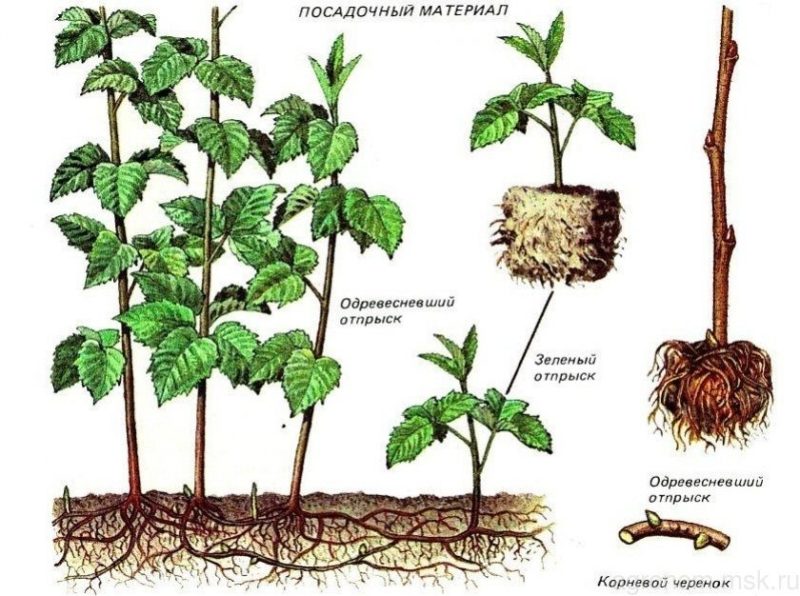
Features of summer cuttings
Experienced gardeners recommend taking into account several features of raspberry cuttings in summer. Green shoots contain less nutrients than mature ones, so long-term storage of such planting material is impossible.
When carrying out the procedure, the balance of forces in the cutting itself and in the developing root system is taken into account. This means that it is important to help the roots grow back before the power in the cutting runs out. Otherwise, the escape will die.
Timing
For harvesting green cuttings, young shoots are used, which grow in large numbers next to the mother bushes. They start harvesting when the shoots grow to about 20 cm in height and develop 2-3 leaves. As a rule, this occurs at the end of spring or in the first half of June.
Work on cutting blanks is carried out in cool rainy weather.
Site requirements
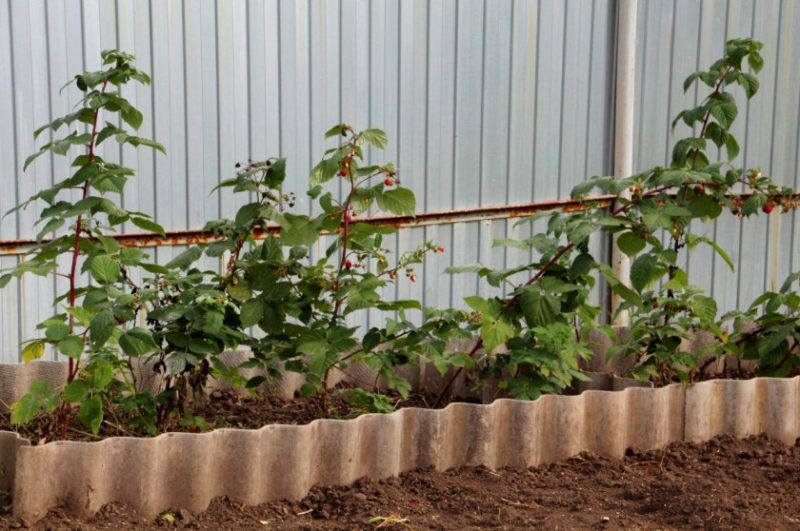
Successful reproduction of raspberries by green cuttings is impossible without meeting certain requirements for the place of rooting of blanks:
- high air humidity - up to 90%;
- constant ambient temperature - + 25… + 30˚C;
- lightweight and moisture-consuming substrate;
- protection from direct sunlight.
Such a microclimate is created in a protected ground: in a greenhouse, a greenhouse or a school. Reproduction by green cuttings gives many plant specimens and allows you to plant a whole raspberry plantation of the variety you like.
Soil preparation
For the rooting of cuttings, fertile soil is used, mixed with organic and mineral fertilizers.Depending on the fertility of the land, from 5 to 20 kg of organic fertilizers, 100 g of superphosphate, 20 g of potassium salt are applied per 1 running meter. If the soil is acidic, add 100–150 g of lime.
Selection and preparation of cuttings
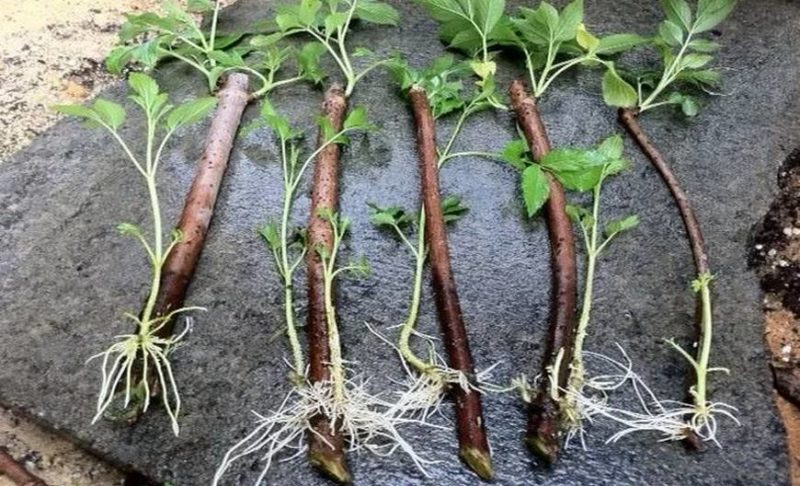
For reproduction in June, blanks are cut from young shoots that have not yet had time to stiffen. This material has a stronger ability to form roots than shoots with a lignified structure.
Cuttings are cut from green shoots with pruners near the ground or with a slight depth of 1 cm. Further cutting is carried out on a hard board with a sharp tool so as not to squeeze the plant tissue.
The lower cut is made oblique to increase the suction surface, 1 cm below the kidney, the upper one is straight, directly above the kidney. To reduce the evaporation area, the leaves are cut in half (preferably on the eve of the procedure to reduce moisture loss). The top of the shoot is shortened so that the total length of the cutting is 8–12 cm.
Important! When harvesting cuttings, special attention is paid to maintaining moisture in the tissues: the success of the entire procedure depends on this. The workpieces are cut in the early morning when plant tissues are saturated with moisture. At all stages of working with cuttings, they are not allowed to dry out, cut shoots are immediately placed in a container with water and placed in the shade. The storage time of the finished material in the refrigerator is no more than 2 days.
After cutting, the bottom of all blanks is placed in a nutrient aqueous solution with a root stimulator. Root regeneration is regulated by growth substances - auxins, carbohydrates and nitrogenous substances. Under the influence of growth regulators, the number of rooted cuttings increases and the quality of finished seedlings increases.
Effective root stimulants include:
- "Heteroauxin" (β-indoleacetic acid, IAA) - from 50 to 200 mg / l;
- "Kornevin" (indolylbutyric acid, IMA) - 1 g / l of water;
- "Zircon" (a mixture of hydroxycinnamic acids) - 1 ml / l of water.
When preparing a nutrient solution, a substance that stimulates growth is first dissolved in a small amount of alcohol, and then added to water. This will make the stimulant work more effectively. Processing is carried out in the dark, at a temperature of + 18 ... + 22 ° C. The stalk is immersed in a solution so that leaves do not fall into it.
After 12-15 hours, the cutting is removed from the solution and planted in a prepared place in a greenhouse, greenhouse or garden bed, under a film cover.
Advice! It is convenient to combine green cuttings with thinning bushes. Strong and healthy removed shoots are not thrown away, but used for rooting.
If possible, a fogging installation is used at the landing site. If it is not there, regular watering and spraying will help to create the necessary level of humidity.
Other ways of rooting
Cuttings are rooted not only in the ground. Other methods include sprouting in water, substrate, and even potatoes.
In water
This is one of the simplest ways that does not require special skills and additional expenses. The harvested cuttings are placed in a container with water (2-3 pieces per 200 ml of liquid) and wait for the roots to appear.
The chances of successful rooting are increased when the following rules are followed:

- the water in the glass is not changed, but topped up if necessary (changing water is stress for plants);
- cuttings are placed in water at room temperature;
- opaque containers are used for rooting: roots form faster in dark glasses;
- activated carbon (2 tablets per 1 tbsp.) or phosphorus-potassium fertilizers (according to the instructions for the preparation) are added to the water.
Compliance with these rules accelerates root formation and prevents rotting of the lower part of the cuttings.
In the substrate
This method involves the use of breathable materials, since oxygen is required for root formation. Mixtures are considered suitable substrates:
- vermiculite and river sand;
- perlite, earth, peat and sand;
- peat, vermiculite, perlite and sand.
All ingredients are mixed in 1: 1 proportions, put into a drawer of a suitable size and moistened. Cuttings are stuck into the finished substrate and wait for the appearance of new leaves.
In potatoes
Raw potatoes are a natural source of root formation stimulants, so they are successfully used for rooting raspberry cuttings. For each shoot take 1 large potato with cut eyes. A piece of stem is stuck into the tuber for 1-2 buds, and the vegetable itself is buried in the ground and watered. Cover everything with a plastic bottle.
Cuttings planted in this way are regularly watered and ventilated by removing the bottles. If everything is done correctly, the first roots will appear in a week.
Cuttings with green shoots
With the help of green cuttings, not only raspberries are propagated, but also other shrubs or trees. The rooting ability of shoots depends on the type and variety of plants.
This method of reproduction is due to the ability of stem cuttings to form adventitious roots. The easiest way to root is lianas (clematis, grapes, actinidia, hydrangea) and shrubs (chubushniki, lilacs, privet, raspberries, honeysuckle).
Cuttings with stiff shoots
Lignified cuttings for breeding raspberries are harvested in the fall and planted in the spring. Step-by-step instructions for growing raspberries in this way:
- After the first frost, several annual woody shoots are divided into cuttings 20–30 cm long. As in the case of propagation by green shoots, one cut is made at an angle, and the second - straight.
- The blanks are wrapped in paper and placed in a cellar, sprinkled with moistened peat or sand.
- In the spring, the lower cut of the cuttings is renewed, they are placed in a solution with a root formation stimulator for 10-15 hours.
- The workpieces are rearranged into a container with sweetened water (1 tsp of sugar per 1 liter of water), covered with a plastic bag and placed in a warm place.
After about a month, roots appear, then the plants are planted in a greenhouse.
Landing
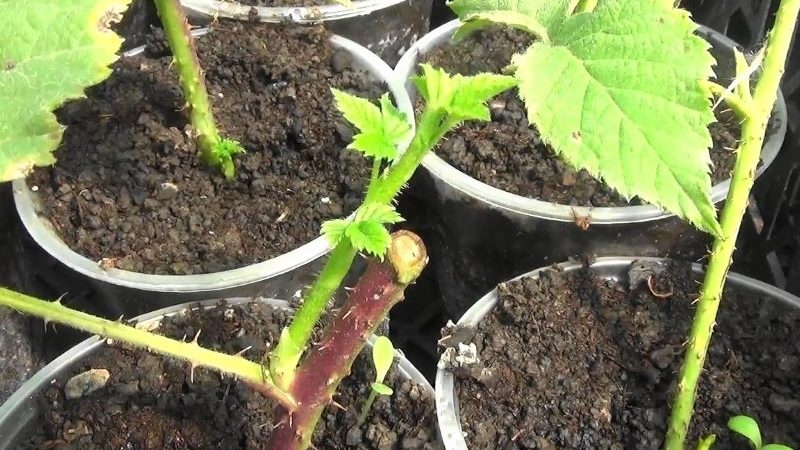
The finished material is planted in a pre-prepared distribution bed in a greenhouse or greenhouse. Previously, it is useful to shed the soil with one of the drugs to suppress pathogenic microflora (for example, "Shining", "Baikal", "Vozrozhdenie", "Fitosporin"). These funds are also used in caring for landings, adding to the water for irrigation once every 1-2 weeks.
The cuttings are planted at a distance of 5–7 cm from each other to a depth of 1.5–2 cm. For raspberry rooting, the optimum temperature is + 25… + 26˚C and humidity 80–90%.
In an industrial environment, moisture is maintained by fogging units that spray moisture at regular intervals. At home, cuttings are sprayed with water several times a day. It is important to inspect them regularly, removing fallen leaves and dead specimens.
It is interesting:
What are the most productive varieties of raspberries
Further care
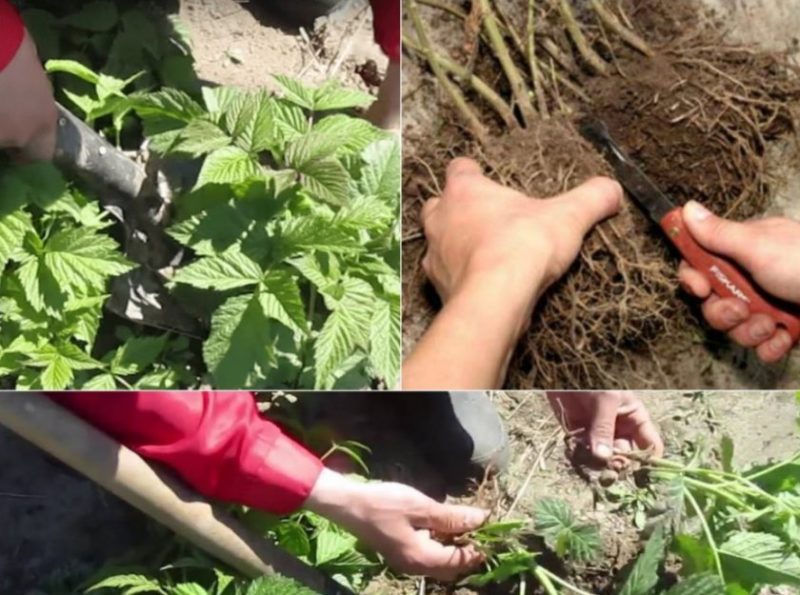
Caring for green cuttings consists in regularly ventilating the greenhouse, watering, creating high humidity, loosening the soil and removing weeds.
To ventilate the shelter, begin by opening the film for 1-2 hours. The time is gradually increased, while the number of sprays is reduced. After hardening the rooted cuttings, the film is removed. To maintain the moisture content of the soil and air, daily watering and spraying is carried out. After 4 weeks, the plants are fed with liquid complex mineral fertilizer.
With proper care, the first green growth appears about a month after planting. Shoot growth begins, the root system branches out. At this stage, the film cover is completely removed during the day, leaving it only overnight. The frequency of watering is reduced.
If there are few cuttings, they are rooted in boxes, pouring about 10 cm of earth and 2 cm of river sand on the bottom. 1-3 shoots can be rooted in a pot by covering with a clear, cut-bottom plastic bottle.Ventilate such a structure by removing the lid from the neck.
On a note!It is convenient to place pots or boxes with cuttings in a cellar or basement for the winter, and plant the shoots in a permanent place in the spring.
2-3 months after planting, grown and rooted shoots are transplanted to a permanent site in fertilized fertile soil, or left in place, covered with dry leaves for the winter, and transplanted in spring.
Nuances of reproduction of remontant raspberries
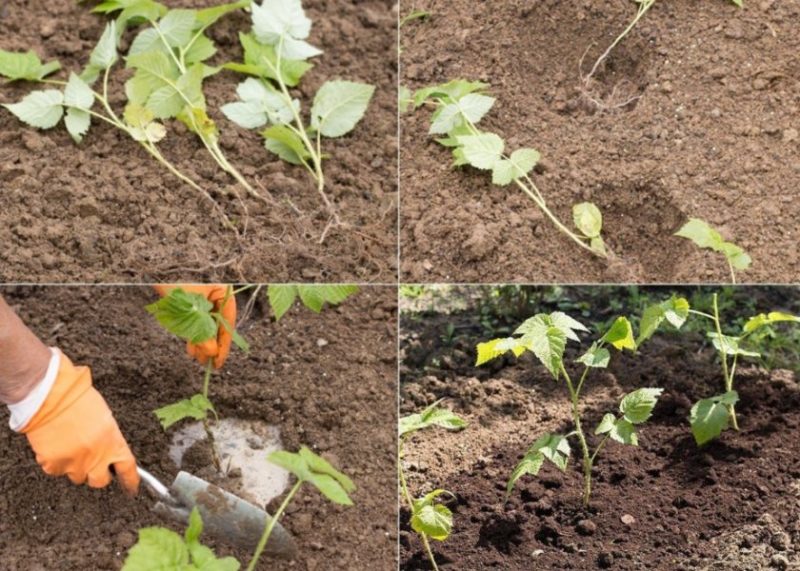
Repaired varieties form shoots differently, so not all traditional breeding methods are applicable in this case. One of the characteristic features of remontant varieties is the weak growth of growth, especially in the first years after planting. A small amount of green shoots and root suckers makes it easier to care for the raspberry tree, but complicates its breeding.
In this case, carefully remove the central part of the bush. In a 2-3-year-old plant in the fall or early spring, carefully cut out the central area with a diameter of up to 15 cm.In response to this pruning raspberries begin to grow root mass and form green shoots.
This technique allows you to prepare many high-quality green cuttings for growing seedlings in the spring, and many root cuttings in the fall. Certain varieties of remontant raspberries, with good care, give a sufficient number of replacement shoots. When removing excess growth in early spring, it is used as green cuttings.
How to propagate yellow raspberries
Most of the varieties of yellow raspberries belong to repairing. These varieties have high yields, large berry sizes, and increased resistance to diseases and pests. The farming technique of yellow raspberry breeding is similar to the cultivation of traditional red varieties.
Breeding with root cuttings is recognized as the most convenient for remontant varieties. Planting material from the mother bush is dug up in the fall, when the plants are dormant.
Sections of roots are harvested at least 2 cm thick and 8–12 cm long. Root cuttings are planted in grooves 6–10 cm deep, at a distance of 15–20 cm from each other. The grooves are covered with fertile soil, watered, mulched and covered with tops or spruce branches to protect them from freezing.
In the spring, the shelter is removed together with the snow melting, the landing site is covered with an air-permeable protective film (until green shoots appear). Further care for raspberries does not differ from usual and includes watering, loosening the soil, killing weeds, applying fertilizers, and protecting against diseases and pests.
Experienced gardening tips
In order for the cuttings to take root faster after planting, they adhere to the following recommendations:
- the material is planted in soil fertilized with mineral and organic means;
- rooted cuttings are covered for the winter with spruce branches or special protective materials;
- in a permanent place, raspberries are planted in well-lit areas with fertile soil and without stagnant water;
- when propagated by green cuttings, they are pre-treated with rooting stimulants;
- after planting, young seedlings are regularly fed with mineral and organic means;
- for the preparation of cuttings, only disinfected sharp instruments are used to prevent tissue soaking and creases at the cut sites.
With proper care, the cuttings will quickly take root in a new place, and the next year after planting they will begin to bear fruit.
Read also:
Raspberry varieties for the middle lane
Instructions for caring for raspberries in spring after winter and advice from experienced gardeners
Conclusion
Raspberries are a two-year-old crop loved by many gardeners. The fragrant berries are tasty and healthy. Therefore, the shrub grows in almost every summer cottage or garden.
It so happens that the seedlings of the variety you like are not sold on the market or cost a lot. In this case, the seedlings are harvested independently from the green growth.Knowing how to cut raspberries, you can grow an entire plantation with only one bush. The main thing is to provide the cuttings with optimal conditions for engraftment and rapid root growth.